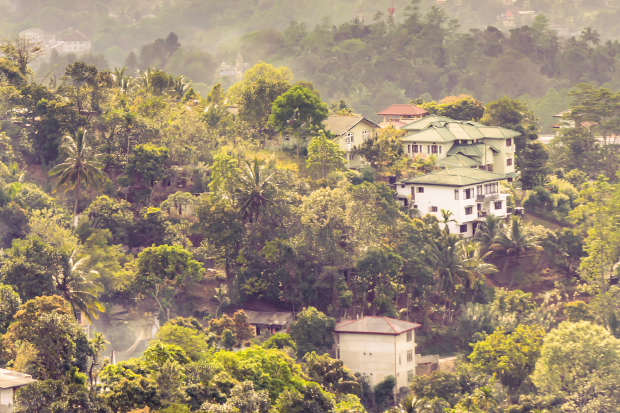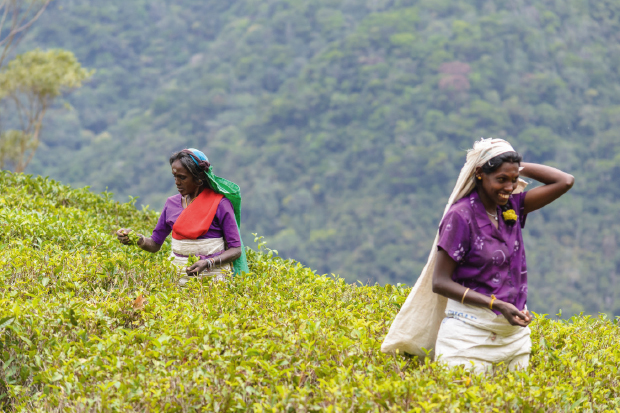Sri Lanka
In my next life, I’m going back in time to become a tea planter in pre-war Ceylon. I half knew this even before I’d ever set foot in Sri Lanka. After a blissful couple of days at Rosyth, an estate house in old tea- growing country about an hour from Kandy, I understood exactly why: the climate, the views, the staff, the sundowners…
Which are the same reasons the colonial British took so particularly well to tea-growing, whether in Assam, Darjeeling, Kenya or Ceylon. It thrives in just the conditions British people tend to find most congenial: pleasantly warm but not boiling; plenty of rain to keep the foliage all lush and green; a bit of height, for the attractive vistas. Tea country is the kind of place where — even though you happen to be in the tropics — you could eat scones and sandwiches on the verandah overlooking your croquet lawn at 4.30 p.m. and not feel remotely self-parodic. It’s just like home, only with better service, nicer cuppas and a more pressing incentive to get hammered on gin and tonics of an evening because of tradition, mosquitos, quinine or something.
Kandy I’m sure once had an awful lot going for it. It’s Sri Lanka’s second city after Colombo (the capital) and was always the one the colonials preferred. It has some beautiful old buildings and the lakeland setting, surrounded by hills, is lovely. But because there’s no bypass (it was blown up during the civil war) it gets horribly congested. So unless you want to see its two main draws — the Temple of the Sacred Tooth (one of the Buddha’s gnashers, very heavily guarded, hidden in a gold casket) and Helga’s Folly, a surrealistic hotel about which the Welsh rock band Stereo-phonics once wrote a song — I’d do what we did and skip straight on to Rosyth, near a less well-visited town called Kegalle.
One of the great things about Rosyth — a 1926 colonial planter’s bungalow that used to belong to the great-uncle of novelist Michael Ondaatje — is that there’s nothing to do there. Well, there is, if you insist: a round at the Victoria Park golf club; a trip to the nearby elephant orphanage at Pinnawala; white-water rafting. But you’re much better off just pottering round the 62-acre estate.
There’s a walk of about an hour you can do — with Rosyth’s very welcoming owners Farzana and Neil, if they’re around — which takes you down past the terraced slopes on which the tea grows to a paddyfield with a jungle backdrop like something out of Apocalypse Now, then back up through a rubber plantation where the white latex trickles down the grooves in the trees’ bark into coconut collecting cups. You’ll see coucals, paradise flycatchers, monkeys. It’s glorious, and if you do it in the late afternoon, you’ll have earned your drink.
Then, of course, there’s the tea factory just above the house. It reminded me of those posters you made in geography lessons at school in the Seventies, where you illustrated in felt tip the different stages of tea-growing, based on fading old posters from the pre-independence era of smiling dark-skinned women in brightly coloured clothes looking happy in their mind-numbingly repetitive work.
It’s still like that today: clanking machinery, at least some of which must date from the 1950s; posters telling the staff not to spit betel juice and others telling visitors — of whom I suspect there are very few — what’s happening on each level of the factory, starting with the ‘withering’ on the top floor where the freshly picked leaves are left to dry in the air, before progressing to the kilns down below.
But it’s the workers who really make it: almost all women, of Southern Indian Tamil heritage, because that’s where the tea plantations traditionally recruited their staff — the indigenous Sinhalese and Tamils being unwilling. In the old days, they worked on indentured contracts only one step short of slave labour. We arrived just as they were trooping merrily off for their tea break, their forewoman carrying a huge teapot.
I’ll be honest, I’ve never been a huge fan of Ceylon tea. Arguably its best known exponent is Sir Thomas Lipton, a great pioneer in the late 19th century of course, but now mainly represented by that horrid stuff in yellow-packaged tea bags drunk in countries where they don’t really understand tea, like France and America. But I love the stuff we brought back from Rosyth, even though it’s grown at too low an altitude to rank with the country’s best: it had a warm, rounded, malty flavour quite unlike anything I’ve tasted at home.
If you go to Rosyth, you’ll wish that you too could live in such Raj-like elegance, amid two-day-old copies of the Times and tropical hardwood easy chairs, with delightful and attentive staff to serve you tea, prepare delicious local food (string hopper breakfasts; curries; or versions of the street food charmingly known as ‘short eats’) and give you cookery lessons (which I highly recommend). You’ll think: ‘I could run a boutique guest house like this.’
But I suspect it’s harder than it looks. You have to cope with nonsense like the visiting inspector from one commercial operator who said, ‘We can’t send our guests here. There are no kettles in the rooms.’ No, Farzana patiently explained: that’s because if guests want tea, they can ask the -butler, Dilantha. (‘Anyway,’ Farzana confided to me, ‘I’m not sure their clients would have been the kind of people who would have really got this place.’) No indeed. But you will, oh you definitely will, all you Spectator readers.
Got something to add? Join the discussion and comment below.
Get 10 issues for just $10
Subscribe to The Spectator Australia today for the next 10 magazine issues, plus full online access, for just $10.
You might disagree with half of it, but you’ll enjoy reading all of it. Try your first month for free, then just $2 a week for the remainder of your first year.
















Comments
Don't miss out
Join the conversation with other Spectator Australia readers. Subscribe to leave a comment.
SUBSCRIBEAlready a subscriber? Log in